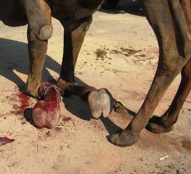HIS Camel Project

The Help in Suffering Camel Rescue Project
- Most of the camels are male and are used for haulage
- Most of the camel owners who earn a livelihood by carrying good such as wood, bricks or building materials, are living on a very low income and earn the equivalent of about $US2 for a long and hard day’s work, for most of the year in temperatures between 40’ to 50’c.
- Male camels are preferred because they are much stronger and more powerful than the female. Most camel owners are deeply attached to the camel which may live and work with the family for ten years or more
- The camel grows a thick winter coat. Unfortunately the tradition in Rajasthan is to shave the camel in winter as it is believed it will be easier to handle. HIS camel team, headed by Dr. Pradeep Singhal, speaks to camel owners when giving treatment, advising that the camel is less likely to catch cold if the winter coat is not shaven
- During winter the male camel goes into rut and becomes very difficult to handle
- In order to control the camel one or two nosepegs with attached rope are used. If used with care and compassion, the nosepeg is the most effective means of controlling the male camel as a halter is not always successful if a male camel wants to fight or suddenly becomes panic-stricken
- Unfortunately many camels are not handled humanely, although they are gentle and obedient animals
- The hole in the nostril through which the nosepeg is inserted can easily become infected or damaged if the nosepeg is pulled roughly or moves around in the nostril, thus causing friction and irritation
- The traditional nosepeg in use in Rajasthan is wooden. The problem with the wooden nosepeg is that it can be rough, is likely to splinter and to absorb fluids exuded from the nose, thus becoming a repository of infection
- The exudate from an irritated nosepeg puncture can attract the gravid screw worm fly, who lays eggs on the wound, from which maggots hatch, eating into the living flesh of the camel’s face
- HIS provides a smooth plastic nosepeg with shorter shaft in substitute for the traditional wooden peg, and also educates owners about the need to handle the camel with care and compassion.
- The load the camel has to pull is often too heavy and there are many injuries of camels on the roads A camel may be expected to pull a load weighing up to 1000 kgs.
‘Rajasthani camel owners use thick, heavy rope attached to the nosepeg, which means that if the nosepeg is pulled through sudden jerking the nostril will tear and can be badly injured. HIS advises use of a thin cotton rope attached to the peg, and this is distributed free to camel owners. The thin cotton string will break if there is a sudden jerking, rather than the camel’s nose tearing.’
Data for the last year (2011)
- Total reflectors – 796
- Total camel dewormed – 1462
- Total camels euthanased- 3
- Total nose-pegs fitted – 1322
- Total emergencies attended- 107
Dr. Pradeep Singhal
We especially thank Animaux Secours (Arthaz, France), the sister society of Help in Suffering, Jaipur, who has assisted so greatly over the years in funding for the HIS Camel Project.
But the project, which helps the poorest of the poor, is constantly in need of funds, due to the cost of running a mobile clinic, employing a vet and two assistants, and supplying drugs, equipment and information to the camel owners so much in need of help.






